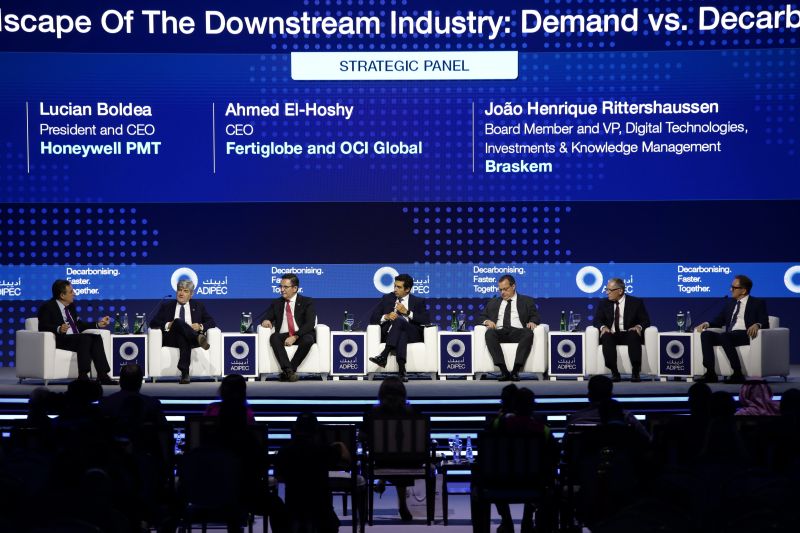
Each year the energy industry converges at ADIPEC, the world’s largest energy conference. It’s a chance for leaders across the ecosystem to come together and find solutions to the industry’s biggest challenge – the transition to a cleaner future.
This year’s record-breaking attendance and representation from more than 160 countries recognizes not only the global importance of the energy industry and its value chains, but that real progress towards decarbonization will require global collaboration.
Over the week, our CEO Ahmed El-Hoshy joined other leaders to discuss what needs to be done to achieve the energy transition and meet global decarbonization targets during panels and roundtable sessions. His key takeaways are that:
1. Methanol and ammonia have a critical role to play
Scaling up the hydrogen economy will be crucial to the energy transition: the Hydrogen Council predicts that hydrogen could meet up to 18 percent of the world’s energy demand by 2050 and generate a market worth up to US$200 billion annually.
Methanol and ammonia can both be produced using renewable or lower carbon processes. Today, they are both heavy users of hydrogen – combined they represent over 50% of hydrogen use – primarily for making fertilizers and used as building blocks in numerous industrial materials. They can also be used as low and zero carbon fuels and feedstocks in new markets, such as transport and power, replacing fossil fuels, meaning they have huge potential to decarbonize fundamental supply chains all over the world.
What makes them such important solutions to decarbonize today, is that they are available, efficient, and safely handled every day. And because they can be scaled up and produced in a low carbon way using existing infrastructure. This means they can be produced, supplied and scaled quicker because they aren’t contingent on the financing and building of new infrastructure.
2. We need regulation to drive demand
Regulation is crucial for driving demand for low carbon and renewable products by penalizing the use of fossil fuels and incentivizing the use of lower carbon or renewable alternatives. We need specific regulations to drive demand within those industries not moving quickly enough to decarbonize.
We see evidence of this in the fact that the only industries that have made any significant moves to cleaner versions are those that have been compelled by regulation – namely the fuels markets.
For road transport, blending mandates in the fuel industry, such as the Renewable Energy Directive in the EU and Renewable Fuel Standards in the US, have accelerated the production and application of renewable fuels. Looking ahead, the introduction of RED III (revised RED II) regulation in the EU will significantly increase emission reduction targets.
We’ve also seen real progress in the maritime industry this year, thanks largely to FuelEU Maritime which targets the industry to reduce GHG by 2% in 2025, 6% in 2030 and 80% in 2050. The latest IMO strategy aims to build on that impact globally, but practical mechanisms, such as a global fuels standard for shipping need to be introduced to spark action outside Europe
In contrast, the agriculture sector has little or no specific regulation in place today to encourage demand from the agricultural sector, meaning progress will remain slow. Something like a “fertilizer blending mandate” could be the missing link to introduce low carbon ammonia in a practical way and scale up the clean hydrogen economy. Fertilizers represent a market-ready application for low carbon and renewable hydrogen.

3. Production needs to be incentivized to meet demand
Regulatory support is also crucial for ensuring the supply is in place to meet the new demand. The IRA in the US is a good example of how regulation can incentivize production. It has allowed companies like OCI to accelerate decarbonization projects thanks to the tax credits system supporting reduction of carbon intensity.
We are already 50% through piling and well underway on construction of a 1.1mtpa blue ammonia plant in Texas in partnership with Linde on a $2.8Bn total complex that is scheduled to be online in 2025, and we recently announced a new partnership with New Fortress Energy where they will provide us with green hydrogen at our site in Beaumont, Texas. The H2 subsidy under the IRA 45V and the $3/kg credit makes green H2 production in the US competitive.
But this all needs to go further – we need global level regulation to reflect global markets and support market certainty. Of the hundreds of green hydrogen projects we’ve seen announced, we expect only a very few to reach FID, and ultimately start producing. One key reason is that producing renewable and lower carbon versions of these products is more expensive. Whether that’s because of the cost of technology, capturing carbon dioxide emitted in production or sourcing renewable feedstocks that cost more than their fossil fuel alternatives.
Critically, there is no established premium to balance the higher production cost today. Putting a price on carbon (via the carbon border adjustment mechanism in Europe for example), is a step in the right direction, but it may not be enough without further regulatory support.

4. Collaboration accelerates change
The nature of global supply chains means that we need collective effort to effect change. We work with partners across our value chains to maximize our impact.
Looking at agriculture: In March, we announced the first of two partnerships to decarbonize food chains with our lower carbon fertilizers, with Simpsons Malt, who took the first UK shipment of our low carbon nitrogen fertilizer as part of a project to significantly reduce the carbon footprint of malting barley and distilling wheat. Then in April, we announced our collaboration with Agravis to pioneer the low carbon production of bread and other flour-based staple foods using wheat grown with our lower-carbon calcium ammonium nitrate (CAN), which is certified by ISCC Plus, which guarantees the responsible sourcing of sustainable raw materials based on a mass balance approach.
In shipping, this year we have announced new partnerships with Unibarge, X-Press Feeder Lines and A.P Moller Maersk to supply them with green methanol, as the marine industry, which is responsible for 3% of global GHG emissions, recognizes the importance of green methanol as a lower carbon fuel.
Last month, the world’s first methanol powered containership, owned by Maersk, completed its maiden voyage, proving the efficacy, safety, and readiness of green methanol. Only by working closely with ports, regulators, and other partners could we make this historic journey a reality.
Ultimately, change cannot happen in a vacuum, which is why ADIPEC is such an important opportunity to come together, celebrate progress and hold one another accountable. As we look ahead to COP28 later this year, demonstrating tangible achievements will be crucial, and we look forward to continuing to achieve industry leading milestones alongside our partners across the energy and hydrogen industries.